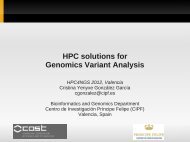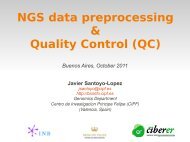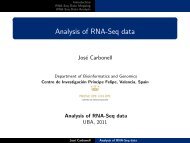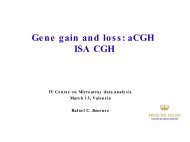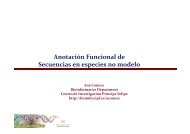Introduction to NGS technologies - Bioinformatics and Genomics ...
Introduction to NGS technologies - Bioinformatics and Genomics ...
Introduction to NGS technologies - Bioinformatics and Genomics ...
You also want an ePaper? Increase the reach of your titles
YUMPU automatically turns print PDFs into web optimized ePapers that Google loves.
<strong>Introduction</strong> <strong>to</strong><br />
<strong>NGS</strong> Technologies<br />
Javier San<strong>to</strong>yo López<br />
Medical Genome Project (MGP)<br />
<strong>Genomics</strong> & <strong>Bioinformatics</strong> Platform of Andalusia (GBPA)*<br />
Sevilla, Spain<br />
javier.san<strong>to</strong>yo@juntade<strong>and</strong>alucia.es<br />
http://www.medicalgenomeproject.com<br />
http://www.gbpa.es<br />
*(Formerly known as Andalusian Human Genome Sequencing Centre - CASEGH)
Genetic Research<br />
…code for<br />
proteins...<br />
Genes in<br />
the DNA...<br />
…produces the final<br />
phenotype<br />
>protein kinase<br />
acctgttgatggcgacagggactgt<br />
atgctgatctatgctgatgcatgcat<br />
gctgactactgatgtgggggctattg<br />
acttgatgtctatc....<br />
From genotype<br />
<strong>to</strong> phenotype.<br />
…whose structure<br />
accounts for<br />
function...<br />
…plus the<br />
environment...
Genetic Research<br />
…code for<br />
proteins...<br />
Genes in<br />
the DNA...<br />
…produces the final<br />
phenotype<br />
>protein kinase<br />
acctgttgatggcgacagggactgt<br />
atgctgatctatgctgatgcatgcat<br />
gctgactactgatgtgggggctattg<br />
acttgatgtctatc....<br />
…whose structure<br />
accounts for<br />
function...<br />
From genotype<br />
<strong>to</strong> phenotype.<br />
…plus the<br />
environment...<br />
Data is information
Information<br />
<strong>Bioinformatics</strong> <strong>to</strong>ols for<br />
pre-genomic sequence data analysis<br />
Molecular<br />
databases<br />
Search results<br />
Phylogenetic<br />
tree<br />
Sequence<br />
Motif<br />
databases<br />
Motif<br />
alignment<br />
Conserved<br />
region<br />
Secondary <strong>and</strong> tertiary protein structure
The aim:<br />
Extracting as much<br />
information as<br />
possible for one single<br />
data
High Throughput Technologies<br />
• 1988 arrayed DNAs were used<br />
• 1991 oligonucleotides are synthesized on a glass slide<br />
through pho<strong>to</strong>lithography (Affymax Research Institute)<br />
• 1995 DNA Microarrays<br />
• 1997 Genome wide Yeast Microarray<br />
Nature Miles<strong>to</strong>nes DNA Technologies
Next Generation Sequencing<br />
600 Gbp per run<br />
…when expressed in the<br />
proper moment <strong>and</strong> place...<br />
>protein kunase<br />
acctgttgatggcgacagggactgtatgct<br />
gatctatgctgatgcatgcatgctgactact<br />
gatgtgggggctattgacttgatgtctatc...<br />
.<br />
Genes in the<br />
DNA...<br />
…which can be different<br />
because of the variability.<br />
10 million SNPs<br />
…whose final<br />
effect configures<br />
the phenotype...<br />
A typical tissue is<br />
expressing among<br />
5,000 <strong>and</strong> 10,000<br />
genes<br />
…code for<br />
proteins...<br />
That undergo posttranslational<br />
modifications, somatic<br />
recombination...<br />
100K-500K proteins<br />
From genotype <strong>to</strong><br />
phenotype.<br />
(in the functional post-genomics<br />
scenario)<br />
…whose structures account for function...<br />
…conforming complex<br />
interaction networks...<br />
Each protein has an<br />
average of 8 interactions<br />
…in cooperation<br />
with other<br />
proteins…
Next Generation Sequencing<br />
SOLID 12Gbp per round<br />
…when expressed in the<br />
proper moment <strong>and</strong> place...<br />
>protein kunase<br />
acctgttgatggcgacagggactgtatgct<br />
gatctatgctgatgcatgcatgctgactact<br />
gatgtgggggctattgacttgatgtctatc...<br />
.<br />
Genes in the<br />
DNA...<br />
…which can be different<br />
because of the variability.<br />
10 million SNPs<br />
…whose final<br />
effect configures<br />
the phenotype...<br />
A typical tissue is<br />
expressing among<br />
5,000 <strong>and</strong> 10,000<br />
genes<br />
…code for<br />
proteins...<br />
That undergo posttranslational<br />
modifications, somatic<br />
recombination...<br />
100K-500K proteins<br />
From genotype Data <strong>to</strong><br />
phenotype.<br />
≠<br />
Information<br />
(in the functional post-genomics<br />
scenario)<br />
…whose structures account for function...<br />
…conforming complex<br />
interaction networks...<br />
Each protein has an<br />
average of 8 interactions<br />
…in cooperation<br />
with other<br />
proteins…
His<strong>to</strong>ry of DNA<br />
Sequencing<br />
1<br />
15<br />
150<br />
1,500<br />
Efficiency<br />
(bp/person/year) 15,000<br />
25,000<br />
50,000<br />
200,000<br />
50,000,000<br />
100,000,000,000<br />
1870<br />
1940<br />
1940<br />
1953<br />
1965<br />
1970<br />
1977<br />
1980<br />
1986<br />
1990<br />
2002<br />
2008<br />
Miescher: Discovers DNA<br />
Avery: Proposes DNA as ‘Genetic Material’<br />
Watson & Crick: Double Helix Structure of DNA<br />
Holley: Sequences Yeast tRNA Ala<br />
Wu: Sequences<br />
Cohesive End DNA<br />
Sanger: Dideoxy Chain Termination<br />
Gilbert: Chemical Degradation<br />
Messing: M13 Cloning<br />
Hood et al.: Partial Au<strong>to</strong>mation<br />
Capillary electrophoresis published<br />
Cycle Sequencing<br />
Improved Sequencing Enzymes<br />
Improved Fluorescent Detection Schemes<br />
Next Generation Sequencing<br />
Improved enzymes & image processing<br />
Adapted from Eric Green, NIH; Adapted from Messing & Llaca, PNAS (1998)
Date Cost per Mb Cost per Genome<br />
Date Cost per Mb Cost per Genome<br />
Sep-01<br />
Mar-02<br />
Sep-02<br />
Mar-03<br />
Oct-03<br />
Jan-04<br />
Apr-04<br />
Jul-04<br />
Oct-04<br />
Jan-05<br />
Apr-05<br />
Jul-05<br />
Oct-05<br />
Jan-06<br />
Apr-06<br />
Jul-06<br />
Oct-06<br />
Jan-07<br />
Apr-07<br />
$5,292.39<br />
$3,898.64<br />
$3,413.80<br />
$2,986.20<br />
$2,230.98<br />
$1,598.91<br />
$1,135.70<br />
$1,107.46<br />
$1,028.85<br />
$974.16<br />
$897.76<br />
$898.90<br />
$766.73<br />
$699.20<br />
$651.81<br />
$636.41<br />
$581.92<br />
$522.71<br />
$502.61<br />
$95,263,072<br />
$70,175,437<br />
$61,448,422<br />
$53,751,684<br />
$40,157,554<br />
$28,780,376<br />
$20,442,576<br />
$19,934,346<br />
$18,519,312<br />
$17,534,970<br />
$16,159,699<br />
$16,180,224<br />
$13,801,124<br />
$12,585,659<br />
$11,732,535<br />
$11,455,315<br />
$10,474,556<br />
$9,408,739<br />
$9,047,003<br />
Jul-07<br />
Oct-07<br />
Jan-08<br />
Apr-08<br />
Jul-08<br />
Oct-08<br />
Jan-09<br />
Apr-09<br />
Jul-09<br />
Oct-09<br />
Jan-10<br />
Apr-10<br />
Jul-10<br />
Oct-10<br />
Jan-11<br />
Apr-11<br />
Jul-11<br />
Oct-11<br />
Jan-12<br />
$495.96<br />
$397.09<br />
$102.13<br />
$15.03<br />
$8.36<br />
$3.81<br />
$2.59<br />
$1.72<br />
$1.20<br />
$0.78<br />
$0.52<br />
$0.35<br />
$0.35<br />
$0.32<br />
$0.23<br />
$0.19<br />
$0.12<br />
$0.09<br />
$0.09<br />
$8,927,342<br />
$7,147,571<br />
$3,063,820<br />
$1,352,982<br />
$752,080<br />
$342,502<br />
$232,735<br />
$154,714<br />
$108,065<br />
$70,333<br />
$46,774<br />
$31,512<br />
$31,125<br />
$29,092<br />
$20,963<br />
$16,712<br />
$10,497<br />
$7,743<br />
$7,666
Pre & Post-genomic databases<br />
EMBL database growth (March 2011)
Pre & Post-genomic databases<br />
EMBL database growth (March 2011)
Pre & Post-genomic databases<br />
EMBL database growth (March 2011)
The size of the human<br />
genome is ~ 3 X 10 9 bp;<br />
almost all of its complexity<br />
is in single-copy DNA.<br />
Genome sizes in nucleotide base pairs<br />
The human genome is thought<br />
<strong>to</strong> contain ~30,000-40,000 genes.<br />
plasmids<br />
viruses<br />
fungi<br />
bacteria<br />
plants<br />
algae<br />
insects<br />
mollusks<br />
bony fish<br />
amphibians<br />
reptiles<br />
birds<br />
mammals<br />
10 4 10 5 10 6 10 7 10 8 10 9 10 10 10 11<br />
http://www3.kumc.edu/jcalvet/PowerPoint/bioc801b.ppt<br />
Computing capabilities (CPU power doubles in ~18-24 moths, hard drive capacity doubles in ~12 moths, network<br />
b<strong>and</strong>width doubles in ~20 moths) should increase : 7-10x in 5 years. Follows Moors’s law<br />
Data projection in 3-5 years: 100x increase in sequencing volume. Still new <strong>technologies</strong> with higher<br />
throughput <strong>to</strong> come very soon !!!
Relative throughput of the different<br />
HT <strong>technologies</strong><br />
<strong>NGS</strong> emerges with a potential of<br />
data production that will,<br />
eventually wipe out<br />
conventional HT <strong>technologies</strong> in<br />
the years coming
Relative throughput of the different<br />
HT <strong>technologies</strong><br />
<strong>NGS</strong> emerges with a potential of<br />
data production that will,<br />
eventually wipe out<br />
conventional HT <strong>technologies</strong> in<br />
the years coming<br />
Too many sequences <strong>to</strong> be h<strong>and</strong>led in a st<strong>and</strong>ard computer
Basics of the “old” technology<br />
•Clone the DNA.<br />
•Generate a ladder of labeled (colored) molecules that are different by 1 nucleotide.<br />
•Separate mixture on some matrix.<br />
•Detect fluoroscope by laser.<br />
•Interpret peaks as string of DNA.<br />
•Strings are 500 <strong>to</strong> 1,000 letters long<br />
•1 machine generates 57,000 nucleotides/run<br />
•Assemble all strings in<strong>to</strong> a genome.
Basics of the “new” Technology<br />
→ Get DNA.<br />
→ Attach it <strong>to</strong> something.<br />
→ Extend <strong>and</strong> amplify signal with some color scheme.<br />
→ Detect fluorochrome by microscopy.<br />
→ Interpret series of spots as short strings of DNA.<br />
→ Strings are 30-250 letters long<br />
→ Multiple images are interpreted as 0.4 <strong>to</strong> 1.2 GB/run/day (1,200,000,000 letters/day).<br />
→ Map or align strings <strong>to</strong> one or many genome.
Whole<br />
Genome<br />
RNA<br />
Communities<br />
Sanger (1st-gen)<br />
Sequencing<br />
Human (early drafts),<br />
model organisms,<br />
bacteria, viruses <strong>and</strong><br />
mi<strong>to</strong>chondria<br />
(chloroplast), low<br />
coverage<br />
cDNA clones, ESTs, Full<br />
Length Insert cDNAs,<br />
other RNAs<br />
Environmental sampling,<br />
16S RNA populations,<br />
ocean sampling,<br />
Next-Gen Sequencing,<br />
<strong>and</strong> 3 rd generation<br />
New human (!), individual genome,<br />
exomes, 2,500 normal (1K genome<br />
project), 25,000 cancer (TCGA <strong>and</strong><br />
ICGC initiatives), CNV, matched<br />
control pairs, time course, raresamples<br />
RNA-Seq: Digitization of<br />
transcrip<strong>to</strong>me, alternative splicing<br />
events, miRNA, allele specific<br />
transcripts<br />
Human microbiome, deep<br />
environmental sequencing, Bar-<br />
Seq<br />
Other<br />
Epigenome, rearrangements,<br />
ChIP-Seq
<strong>NGS</strong> <strong>technologies</strong><br />
Cost-effective<br />
Fast<br />
Ultra throughput<br />
Cloning-free<br />
Short reads
Differences between the various platforms:<br />
• Nanotechnology used.<br />
• Resolution of the image analysis.<br />
• Chemistry <strong>and</strong> enzymology.<br />
• Signal <strong>to</strong> noise detection in the software<br />
• Software/images/file size/pipeline<br />
• Cost
Similarities- LOTS of DATA<br />
General ways of dealing at the sequences<br />
• Assemble them <strong>and</strong> look at what you have<br />
• You map them (align against a known genome) <strong>and</strong> then look at what you<br />
have.<br />
• Or a mixture of both!<br />
• Sometimes you select the DNA you are sequencing<br />
• or you try <strong>to</strong> sequence everything<br />
• Depends on biological question, sequencing machine you have, <strong>and</strong> how<br />
much time <strong>and</strong> money you have.<br />
• <strong>NGS</strong> is relatively cheap but think what you want <strong>to</strong> answer, because the<br />
analysis won’t do magic
Similarities- LOTS of DATA<br />
General ways of dealing at the sequences<br />
• Assemble them <strong>and</strong> look at what you have<br />
• You map them (align against a known genome) <strong>and</strong> then look at what you<br />
have.<br />
• Or a mixture of both!<br />
• Sometimes you select the DNA you are sequencing<br />
• or you try <strong>to</strong> sequence everything<br />
• Depends on biological question, sequencing machine you have, <strong>and</strong> how<br />
much time <strong>and</strong> money you have.<br />
• <strong>NGS</strong> is relatively cheap but think what you want <strong>to</strong> answer, because the<br />
analysis won’t do magic
Next-gen sequencers<br />
From John McPherson, OICR<br />
100 Gb<br />
Illumina/HiSeq short-read sequencers 10-600Gb,<br />
150/150 bp, 11 days<br />
AB/SOLiD5500, 200+Gb,75/35 bp reads, 10 days<br />
bases per machine run<br />
10 Gb<br />
1 Gb<br />
100 Mb<br />
Roche 454 GS FLX+ 2.8<br />
(0.2-1Gb in 800-1000 bp reads,<br />
1M reads, 20 hours)<br />
10 Mb<br />
1 Mb<br />
ABI capillary sequencer<br />
(0.04-0.08 Mb in 450-800 bp reads,<br />
96 reads, 1-3 hours)<br />
10 bp 100 bp<br />
1,000 bp<br />
read length
3 main platforms:<br />
- Solexa/illumina<br />
- Roche 454<br />
- ABI SOLiD<br />
Next Generation Sequencers<br />
•Follow an approach similar <strong>to</strong> Sanger sequencing, but do<br />
away with separation of fragments by size <strong>and</strong> “read” the<br />
sequence as the reaction occurs<br />
•Several different “next generation” sequencing platforms<br />
developed <strong>and</strong> commercialized, more on the way.<br />
•Simultaneously sequence entire libraries of DNA sequence<br />
fragments
454 (Roche)<br />
-First next generation method <strong>to</strong> be commercially available<br />
- Uses a “sequencing by synthesis” approach:<br />
• DNA is broken in<strong>to</strong> pieces of 500-1,400 bp, ligated <strong>to</strong> adap<strong>to</strong>rs, <strong>and</strong> amplified<br />
on tiny beads by PCR (emulsion PCR)<br />
• Beads (with DNA attached) are placed in<strong>to</strong> tiny wells (one bead per well) on a<br />
PicoTiter Plate that has millions of wells. Each well is connected <strong>to</strong> an optical<br />
fibre.<br />
• DNA is sequenced by adding polymerase <strong>and</strong> DNA bases containing<br />
pyrophosphate. The different bases (A,C,G,T) are added sequentially in a flow<br />
chamber<br />
• When a base complementary <strong>to</strong> the template is added, the pyrophosphate is<br />
released <strong>and</strong> a burst of light is produced<br />
• The light is detected <strong>and</strong> used <strong>to</strong> call the base<br />
- Initially 100-150 bp, but they have been improved <strong>to</strong> 600-1000 bp<br />
- >1 million, filter-passed reads per run (20 hours)<br />
- 1 billion bases per day
Roche 454 pyrosequencing
Roche 454 pyrosequencing
Roche / 454 : GS FLX<br />
• Good for<br />
• “de novo“ sequencing (longer reads).<br />
• Resequencing (expensive)<br />
• New bacterial genomes.<br />
• Amplicons<br />
• Pyrosequencing. Bias with long polinucleotide streches
Roche 454
GS Junior, bench<strong>to</strong>p
Solexa (Illumina)<br />
•Over 90% of all sequencing data is produced on Illumina systems.<br />
•Uses a “sequencing by synthesis” approach:<br />
• DNA is broken in<strong>to</strong> small fragments <strong>and</strong> ligated <strong>to</strong> an adap<strong>to</strong>r.<br />
• The fragments are attached <strong>to</strong> the surface of a flow cell <strong>and</strong><br />
amplified.<br />
• DNA is sequenced by adding polymerase <strong>and</strong> labeled reversible<br />
termina<strong>to</strong>r nucleotides (each base with a different color).<br />
• The incorporated base is determined by fluorescence.<br />
• The fluorescent label is removed from the termina<strong>to</strong>r <strong>and</strong> the 3’<br />
OH is unblocked, allowing a new base <strong>to</strong> be incorporated<br />
•Started with 35 bp, increased now <strong>to</strong> up <strong>to</strong> 150 bp<br />
•One run can give up <strong>to</strong> 10-600 Gb, 300-6000 million paired-end reads<br />
•75-85% of bases at or above Q30
Solexa / illumina<br />
From Michael Metzker, http://view.ncbi.nlm.nih.gov/pubmed/19997069
Solexa / illumina<br />
From Michael Metzker, http://view.ncbi.nlm.nih.gov/pubmed/19997069
Solexa / illumina<br />
From Debbie Nickerson, Department of Genome Sciences, University of Washing<strong>to</strong>n, http://tinyurl.com/6zbzh4
Illumina-HiSeq 2500<br />
600 Gb/run in 11 days<br />
2x100 bp fragments<br />
6 billion reads per run
Illumina-MiSeq<br />
175-245 Mb 4h 1x 36bp<br />
1.5-2.0 Gb 27h 2x150 bp
•Colorspace<br />
SOLiD (ABI / Life Technologies)<br />
•“sequencing by ligation” method<br />
•Does not use polymerase, instead uses DNA ligase for sequencing:<br />
• DNA is broken in<strong>to</strong> small fragments <strong>and</strong> ligated <strong>to</strong> an adap<strong>to</strong>r.<br />
• The fragments are attached <strong>to</strong> beads <strong>and</strong> amplified by emulsion PCR.<br />
Beads are attached <strong>to</strong> the surface of a glass slide.<br />
• DNA is sequenced by adding 8-mer fluorescently labelled<br />
oligonucleotides<br />
• If an oligo is complementary <strong>to</strong> the template, it will be ligated <strong>and</strong> 2 of<br />
the bases can be called.<br />
• The attached oligo is then cut <strong>to</strong> remove the label <strong>and</strong> the next set of<br />
labelled oligos are added<br />
• The process is repeated from different starting points (using different<br />
universal primers) so that each base is called twice<br />
•200 Gb, 1.8 billion reads per run, 35bp-75bp, 10 days
SOLiD
SOLiD<br />
* Sequencing output in<br />
“color space”<br />
* Needs reference genome<br />
<strong>to</strong> translate <strong>to</strong> base space.
SOLiD<br />
From Michael Metzker, http://view.ncbi.nlm.nih.gov/pubmed/19997069
SOLiD_Dibase_Sequencing_<strong>and</strong>_Color_Space_Analysis.pdf
SOLiD_Dibase_Sequencing_<strong>and</strong>_Color_Space_Analysis.pdf
SOLiD color space<br />
SOLiD_Dibase_Sequencing_<strong>and</strong>_Color_Space_Analysis.pdf
AB SOLiD: Dibase Sequencing<br />
AB SOLiD reads look like this:<br />
T012233102 T012033102<br />
A C G T<br />
A 0 1 2 3<br />
C 1 0 3 2<br />
G 2 3 0 1<br />
T 3 2 1 0<br />
0 0<br />
2<br />
A<br />
G<br />
1 3 3 1<br />
C<br />
T<br />
2<br />
0<br />
0<br />
Mike Brudno, U of Toron<strong>to</strong> http://bioinformatics.ca/files/CBW - presentations/HTSeq_2009_Module 2/HTSeq_2009_Module 2.ppt
AB SOLiD: Dibase Sequencing<br />
AB SOLiD reads look like this:<br />
T012233102<br />
T G A G C G T T C<br />
T012033102<br />
T G A A T A G G A<br />
A C G T<br />
A 0 1 2 3<br />
C 1 0 3 2<br />
G 2 3 0 1<br />
T 3 2 1 0<br />
0 0<br />
2<br />
A<br />
G<br />
1 3 3 1<br />
C<br />
T<br />
2<br />
0<br />
0<br />
Mike Brudno, U of Toron<strong>to</strong> http://bioinformatics.ca/files/CBW - presentations/HTSeq_2009_Module 2/HTSeq_2009_Module 2.ppt
AB SOLiD: Dibase Sequencing<br />
AB SOLiD reads look like this:<br />
T012233102<br />
T G A G C G T T C<br />
T012033102<br />
T G A A T A G G A<br />
TGAGCGTTC<br />
|||<br />
TGAATAGGA<br />
Mike Brudno, U of Toron<strong>to</strong> http://bioinformatics.ca/files/CBW - presentations/HTSeq_2009_Module 2/HTSeq_2009_Module 2.ppt
AB SOLiD: Variations<br />
SOLiD_Dibase_Sequencing_<strong>and</strong>_Color_Space_Analysis.pdf
5500XL SOLiD<br />
200 Gb/run (microbeads)<br />
300 Gb/run (nanobeads)<br />
35-75 bp fragments<br />
1.8 - 4.8 billion reads/run<br />
2x6 lanes/run<br />
96 bar-codes<br />
ECC: 99.99% accuracy
SOLiD 5500<br />
*Sixth 3-based encoded<br />
primer<br />
*Sequencing output in<br />
base space<br />
* No reference needed
PacBio<br />
From Michael Metzker, http://view.ncbi.nlm.nih.gov/pubmed/19997069
Pacific<br />
Bioscience<br />
SMRT: Singel Molecule Real<br />
time DNA synthesis<br />
Up <strong>to</strong> 12000 nt<br />
50 bases/second<br />
ZMW: Zero Mode Waveguide
Ion Torrent<br />
$ 50.000<br />
$ 500 /sample<br />
1 hour/run<br />
> 200 nt lengths<br />
Reads H+ released by DNA<br />
polymerase
Ion Pro<strong>to</strong>n
OXFORD<br />
NANOPORE<br />
The MinION is a memory key–sized disposable<br />
unit that can be plugged in<strong>to</strong> a lap<strong>to</strong>p for under<br />
$1,000, according <strong>to</strong> the company.
Comparison<br />
Roche 454 Illumina SOLiD<br />
•Long fragments<br />
•Errors: poly nts<br />
•Low throughput<br />
•Expensive<br />
•De novo sequencing<br />
•Amplicon sequencing<br />
•RNASeq<br />
•Short fragments<br />
•Errors: Hexamer bias<br />
•High throughput<br />
•Cheap<br />
•Resequencing<br />
•De novo sequencing<br />
•ChipSeq<br />
•RNASeq<br />
•MethylSeq<br />
•Short fragments<br />
•Color-space<br />
•High throughput<br />
•Cheap<br />
•Resequencing<br />
•ChipSeq<br />
•RNASeq<br />
•MethylSeq
Basic steps <strong>NGS</strong> data processing<br />
QC <strong>and</strong><br />
read cleaning
Basic steps <strong>NGS</strong> data processing<br />
QC <strong>and</strong><br />
read cleaning<br />
Mapping
Basic steps <strong>NGS</strong> data processing<br />
QC <strong>and</strong><br />
read cleaning<br />
Mapping<br />
Feature<br />
identification
Basic steps <strong>NGS</strong> data processing<br />
QC <strong>and</strong><br />
read cleaning<br />
Mapping<br />
Feature<br />
identification<br />
DNA<br />
Binding site
File formats<br />
fastq: sequence data <strong>and</strong> qualities<br />
SAM/BAM: mapping data <strong>and</strong> qualities
Most common applications of <strong>NGS</strong><br />
RNA-seq /Transcrip<strong>to</strong>mics<br />
o Quantitative<br />
o Descriptive<br />
Alternative splicing<br />
o miRNA profiling<br />
Resequencing<br />
o Mutation calling<br />
o Profiling<br />
oGenome annotation<br />
De novo sequencing<br />
Exome sequencing<br />
Targeted sequencing<br />
ChIP-seq /Epigenomics<br />
o Protein-DNA interactions<br />
o Active transcription fac<strong>to</strong>r binding<br />
sites<br />
oHis<strong>to</strong>ne methilation<br />
Metagenomics<br />
Metatranscrip<strong>to</strong>mics<br />
Copy number variation
DNA sequencing - 1<br />
• Whole GENOME<br />
Resequencing<br />
– Need reference<br />
genome<br />
– Variation discovery
DNA sequencing - 2<br />
• Whole GENOME “de novo” sequencing<br />
– Uncharacterized genomes with no reference genome available<br />
– known genomes where significant structural variation is expected.<br />
– Long reads or mate-pair libraries. Sequencing mostly done by<br />
Roche 454 <strong>and</strong> also Illumina.<br />
– Assembly of reads is needed: Computational intensive<br />
• E.g. Genome bacteria sequencing
DNA sequencing - 3<br />
• Whole EXOME Resequencing<br />
– Need reference genome<br />
• Available for Human <strong>and</strong> Mouse<br />
– Variation discovery on ORFs<br />
• 2% of human genome (lower cost)<br />
• 85% disesease mutation are in the<br />
exome<br />
– Need probes complementary <strong>to</strong><br />
exons<br />
• Nimblegen<br />
• Agilent<br />
• E.g. Human exome
• Targeted Resequencing<br />
– Capture of specific regions in the<br />
genome<br />
DNA sequencing - 4<br />
• Cus<strong>to</strong>m genes panel sequencing<br />
– Allows <strong>to</strong> cover high number of genes<br />
related <strong>to</strong> a disease<br />
– E.g. Disease gene panel<br />
• Low cost <strong>and</strong> quicker than capillary<br />
sequencing<br />
• Multiplexing is possible<br />
• Need cus<strong>to</strong>m probes complementary<br />
<strong>to</strong> the genomic regions<br />
– Nimblegen<br />
– Agilent
DNA sequencing - 5<br />
• Amplicon sequencing<br />
– Sequencing of regions amplified<br />
by PCR.<br />
– Shorter regions <strong>to</strong> cover than<br />
targeted capture<br />
– No need of cus<strong>to</strong>m probes<br />
– Primer design is needed<br />
– High fidelity polymerase<br />
– Multiplexing is needed<br />
• E.g. P53 exon amplicon<br />
sequencing
Transcrip<strong>to</strong>mics - 1<br />
• RNA-Seq<br />
– Sequencing of mRNA<br />
– rRNA depleted samples<br />
– Very high dynamic range<br />
– No prior knwoledge of expressed genes<br />
– Gives information about (richer than microarrays)<br />
• Differential expression of known or unknown transcripts during a<br />
treatment or condition<br />
• Isoforms <strong>and</strong><br />
• New alternative splicing events<br />
• Non-coding RNAs<br />
• Post-transcriptional mutations or editing,<br />
• Gene fusions.
Transcrip<strong>to</strong>mics - 1<br />
• RNA-Seq<br />
– Sequencing of mRNA<br />
– Detecting gene fusions
Transcrip<strong>to</strong>mics - 2<br />
• SAGE. Serial Analysis of Gene<br />
Expression<br />
– Quantification of gene expression levels<br />
on a genome-wide scale.<br />
– Determines mRNA expression by<br />
sequencing unique sequence tags<br />
isolated from the 3’ ends of mRNAs<br />
– Advantages over microarrays:<br />
• Detects known <strong>and</strong> novel mRNAs.<br />
• Is highly reproducible with a dynamic<br />
range of > 105.<br />
– SAGE strategy is the better if looking at<br />
changes in expression levels of known<br />
transcripts during a treatment or<br />
condition.
Applications of RNAseq<br />
Qualitative:<br />
* Alternative splicing<br />
* Antisense expression<br />
* Extragenic expression<br />
* Alternative 5’ <strong>and</strong> 3’ usage<br />
* Detection of fusion transcripts<br />
….<br />
Quantitative:<br />
* Differential expression<br />
* Dynamic range of gene expression<br />
….
Applications of RNAseq<br />
Qualitative:<br />
* Alternative splicing<br />
* Antisense expression<br />
* Extragenic expression<br />
* Alternative 5’ <strong>and</strong> 3’ usage<br />
* Detection of fusion transcripts<br />
….<br />
Quantitative:<br />
* Differential expression<br />
* Dynamic range of gene expression<br />
….<br />
Tophat/Cufflinks<br />
Scripture<br />
Alexa<br />
edgeR<br />
DESeq<br />
baySeq<br />
NOISeq
Advantages of RNAseq?<br />
RNAseq<br />
microarrays<br />
* Non targeted transcript detection<br />
* No need of reference genome<br />
* Str<strong>and</strong> specificity<br />
* Find novels splicing sites<br />
* Larger dynamic range<br />
* Detects expression <strong>and</strong> SNVs<br />
* Detects rare transcripts<br />
….<br />
* Restricted <strong>to</strong> probes on array<br />
* Needs genome knowledge<br />
* Normally, not str<strong>and</strong> specific<br />
* Exon arrays difficult <strong>to</strong> use<br />
* Smaller dynamic range<br />
* Does not provide sequence info<br />
* Rare transcripts difficult<br />
….<br />
<strong>and</strong>…. are there any disadvantages?????
Transcrip<strong>to</strong>mics - 3<br />
• miRNA/small nonCoding<br />
RNA sequencing<br />
– RNA Size selection step<br />
• 18-40 bp<br />
– Profiling of known miRNAs<br />
– miRNA discovery
TFBS detection<br />
ChIP-Seq<br />
– Identification of<br />
genomic region for<br />
gDNA binding<br />
proteins:<br />
• Transcription Fac<strong>to</strong>r<br />
binding site detection
Egigenomics - I<br />
Epigenomics refers <strong>to</strong><br />
functionally relevant<br />
modifications <strong>to</strong> the genome<br />
that do not involve a change<br />
in the nucleotide sequence<br />
• Play a role in turning<br />
genes off or on<br />
Epigenomic Marks.<br />
a) Methyl groups attach <strong>to</strong><br />
the backbone of a DNA<br />
molecule.<br />
b) A variety of chemical tags<br />
attach <strong>to</strong> the tails of<br />
his<strong>to</strong>nes. This action<br />
affects how tightly DNA is<br />
wound around the<br />
his<strong>to</strong>nes.<br />
ChIP-Seq: His<strong>to</strong>ne methylation detection
Egigenomics - 2<br />
• Methyl-Seq<br />
– CpG isl<strong>and</strong> methylation<br />
– Bisulfite sequencingbased<br />
method<br />
> E.g. Cancer studies.<br />
• Different degree of<br />
chromatin methylation<br />
affects expression of<br />
genes
Egigenomics - 2<br />
MeDIP-Seq,<br />
methylated-DNA<br />
immunoprecipitation<br />
‣Similar <strong>to</strong> ChIP-Seq<br />
‣Immunoprecipitating<br />
methylated DNA with an<br />
antibody raised against 5′-<br />
methylcy<strong>to</strong>sine.<br />
‣The unmethylated DNA is<br />
washed away, leaving the<br />
material highly enriched for<br />
methylated DNA
Metagenomics<br />
The application of modern<br />
genomics techniques <strong>to</strong> the<br />
study of communities of<br />
microbial organisms directly in<br />
their natural environments,<br />
bypassing the need for isolation<br />
<strong>and</strong> lab cultivation of individual<br />
species<br />
– A sample may contain many<br />
different microorganisms,<br />
• 16s Sequencing<br />
• Shotgun genome sequencing<br />
• Transcrip<strong>to</strong>me sequencing
Census <strong>NGS</strong> methods
Successful <strong>NGS</strong><strong>to</strong>ries
Miller syndrome
Species composition of metagenomic DNA<br />
extracted from mammoth hair
No so far…. Sequencing Centers
Andalusian Human Genome Sequencing Center<br />
CASEGH<br />
Cartuja 93<br />
Scientific <strong>and</strong> Technology Park<br />
Sevilla
CASEGH
SEQUENCING LAB
Two<br />
<strong>technologies</strong> <strong>to</strong><br />
scan for<br />
variations<br />
<strong>Genomics</strong> Unit<br />
454 Roche<br />
Longer reads<br />
Lower<br />
coverage<br />
Structural variation<br />
•Amplifications<br />
•Deletions<br />
•CNV<br />
•Inversions<br />
•Translocations<br />
SOLiD ABI<br />
Shorter reads<br />
Higher<br />
coverage<br />
Variants<br />
•SNVs<br />
• Small indels
High<br />
Performance<br />
Computing<br />
Cluster
<strong>Bioinformatics</strong> Unit<br />
24 High Performance Computing nodes – 72-192 Gb RAM<br />
2 Control nodes - 24 Gb RAM<br />
o<br />
o<br />
o<br />
2 x Quad core CPU<br />
16 threads<br />
2 x 10Gb Network interface<br />
Execution of 400 jobs in parallel<br />
S<strong>to</strong>rage 540 Tb <strong>to</strong>tal
Services at CASEGH
The Medical Genome Project (MGP)<br />
Public Funding:<br />
•Andalucia Health System.<br />
•Central government.<br />
•European Regional Development Fund<br />
(ERFD).<br />
Private Funding:<br />
•454 Life Sciences (Roche).
The MGP Scope <strong>and</strong> Aims<br />
• Medical Genome Project’s (MGP) general goals<br />
are:<br />
– Identify novel genes responsible for inherited rare<br />
diseases<br />
– Identify susceptibility genes for common diseases<br />
– Use the results of genetic research <strong>to</strong> discover new<br />
drugs acting on new targets (new genes associated<br />
with human disease pathways)
The MGP Scope <strong>and</strong> Aims<br />
• Medical Genome Project’s (MGP) specific goals are:<br />
– The characterization of a great number of genetic diseases by means<br />
of exome sequencing.<br />
• Diseases on study are genetic Rare Diseases<br />
• Monogenic diseases<br />
– To characterize SNPs in a healthy control population<br />
• 300 Individuals<br />
• MGP will be used as the first steps <strong>to</strong>wards the<br />
implementation of genomic <strong>and</strong> personalized<br />
medicine in the Andalusian HEALTHCARE<br />
SYSTEM. A system covering a population of 8.5<br />
million.
Exome capture<br />
• Focus on the Most Relevant Portion of the Genome<br />
• “Exome” (all exons in the genome):<br />
– the most functionally relevant ~2% of the genome.<br />
– where the majority of known inherited disease-causing<br />
mutations reside.
Normalized coverage<br />
Exome capture reproducibility<br />
Normalized coverage per exon for different samples<br />
X 3Gb<br />
X 4Gb<br />
X 5Gb<br />
Normalized coverage
Normalized coverage<br />
Exome capture reproducibility<br />
Normalized coverage per exon for different samples<br />
>98% correlation of normalized exon coverage for<br />
library pairs<br />
Average coverage <strong>and</strong> distribution of coverage is quite<br />
consistent between experiments<br />
X 3Gb<br />
X 4Gb<br />
X 5Gb<br />
Normalized coverage
Exome sequencing work-flow for Variant detection<br />
Gene A<br />
Produce shotgun<br />
library<br />
Gene B<br />
DNA (patient)<br />
Capture exome<br />
sequences<br />
Map against<br />
reference genome<br />
Determine<br />
variants,<br />
Filter, compare<br />
patients<br />
c<strong>and</strong>idate genes<br />
Wash & Sequence
Bioinformatic analysis<br />
Primary analysis pipeline (Au<strong>to</strong>matic)<br />
Au<strong>to</strong>matic QC<br />
Preprocess<br />
Position / quality<br />
Mapping<br />
Variant Calling<br />
Annotation<br />
<strong>and</strong> filtering<br />
Base composition<br />
Nucleotide QC<br />
Sequence cleaning<br />
BFAST<br />
SAM <strong>to</strong> BAM<br />
Sort BAM<br />
Clean BAM<br />
Index BAM<br />
Variation<br />
FastQ<br />
Color space<br />
200M reads<br />
4-6 hours* 8-12 hours* 8-12 hours* minutes<br />
* 8CPUs 200Mreads (>25-30 Exomes per week)
SNPs distribution across samples
New Variation Types
Secondary analysis:<br />
Finding the mutations causative of diseases<br />
The simplest case: monogenic disease due <strong>to</strong> a<br />
single gene<br />
A<br />
B<br />
C<br />
Controls<br />
D<br />
E<br />
Cases
The principle:<br />
comparison of patients (or families)<br />
<strong>and</strong> reference controls<br />
mutation<br />
Patient 1<br />
Patient 2<br />
Patient 3
The principle:<br />
comparison of patients (or families)<br />
<strong>and</strong> reference controls<br />
mutation<br />
Patient 1<br />
Patient 2<br />
Patient 3<br />
Control 1<br />
Control 2<br />
Control 3
The principle:<br />
comparison of patients (or families)<br />
<strong>and</strong> reference controls<br />
mutation<br />
Patient 1<br />
Patient 2<br />
Patient 3<br />
Control 1<br />
Control 2<br />
Control 3<br />
c<strong>and</strong>idate gene (shares mutation for all patients but no controls)
Is this approach realistic?<br />
Can we detect such rare variants so easily?<br />
a)Interrogating 50Mb produces <strong>to</strong>o many<br />
variants<br />
b)In many cases we are not hunting new but<br />
known variants<br />
c) Same phenotype can be due <strong>to</strong> different<br />
mutations <strong>and</strong> different genes
Filtering with multiple family information<br />
Families<br />
1 2 3 4 5 6<br />
Variants 3403 82 4 0 0 0<br />
Genes 2560 331 35 8 1 0<br />
Problem: how <strong>to</strong> prioritize putative c<strong>and</strong>idate genes
Clear individual gene associations are difficult<br />
<strong>to</strong> find in some diseases<br />
Controls<br />
Cases<br />
They can have different mutations (or combinations).<br />
Many cases have <strong>to</strong> be used <strong>to</strong> obtain significant associations <strong>to</strong> many markers.<br />
The only common element is the pathway (yet unknow) affected.
<strong>NGS</strong> is revolutionizing<br />
how we do genome<br />
research<br />
Conclusions
<strong>NGS</strong> is revolutionizing<br />
how we do genome<br />
research<br />
Conclusions
<strong>NGS</strong> is revolutionizing<br />
how we do genome<br />
research<br />
Conclusions
THANK YOU




